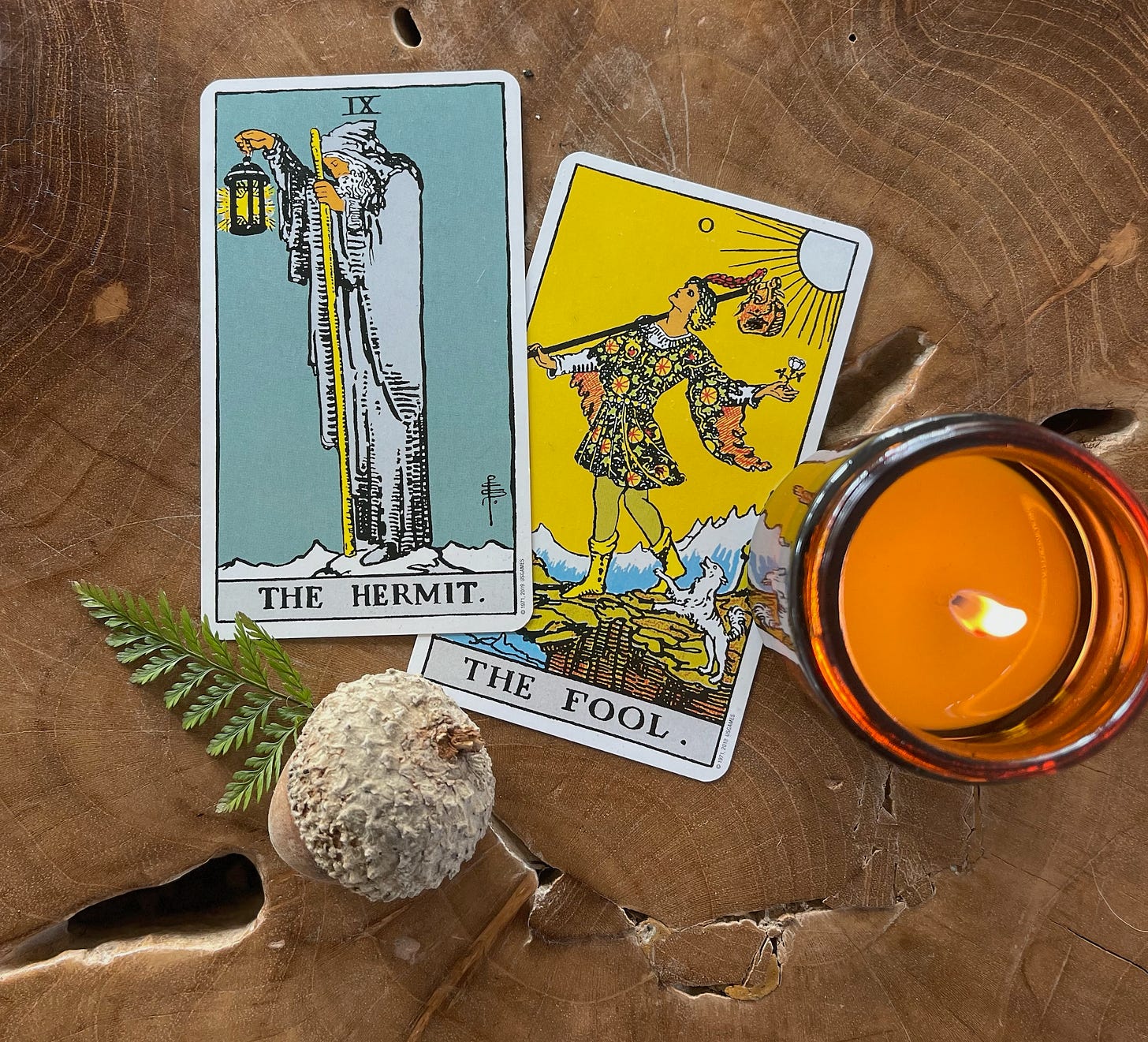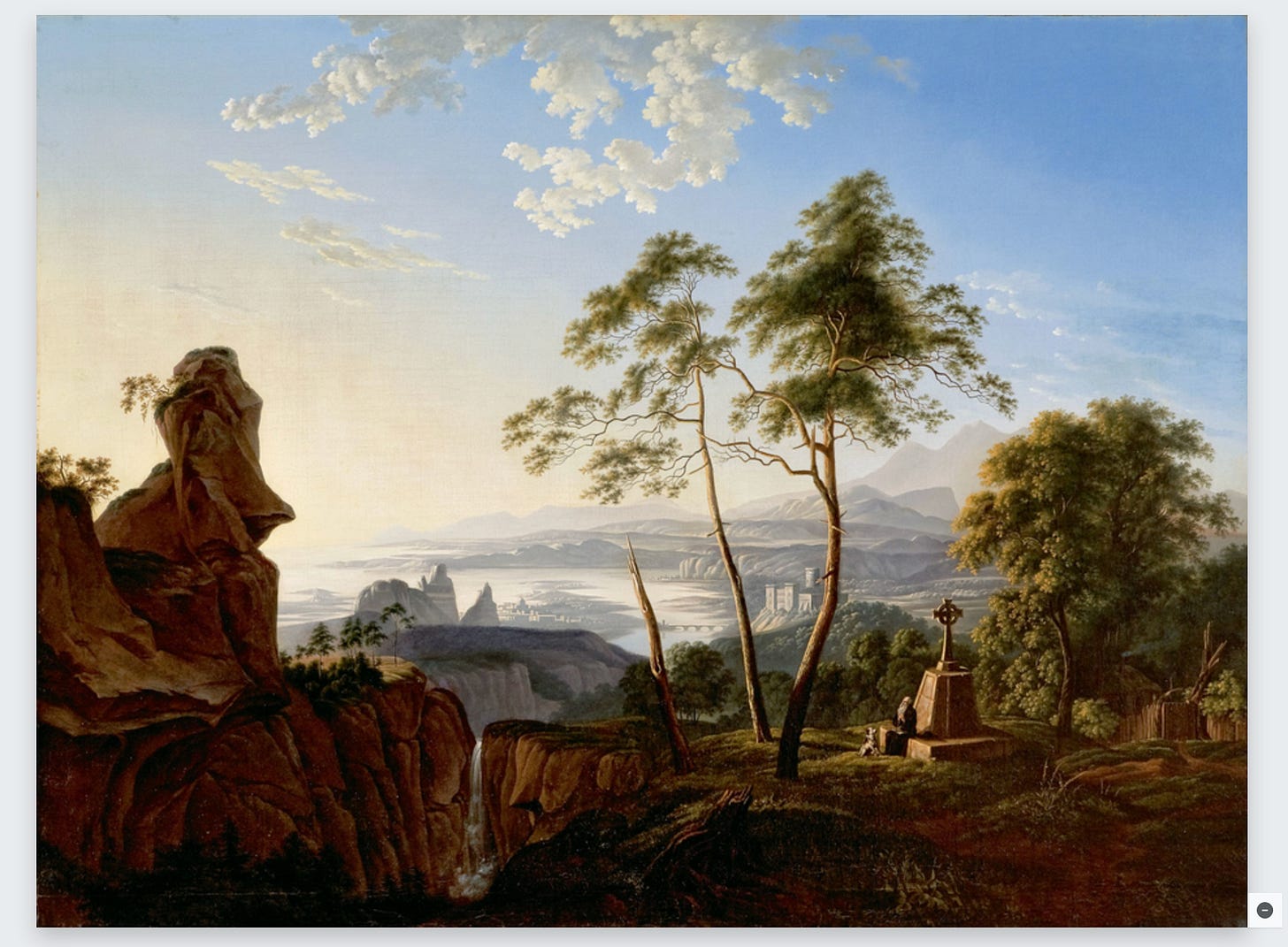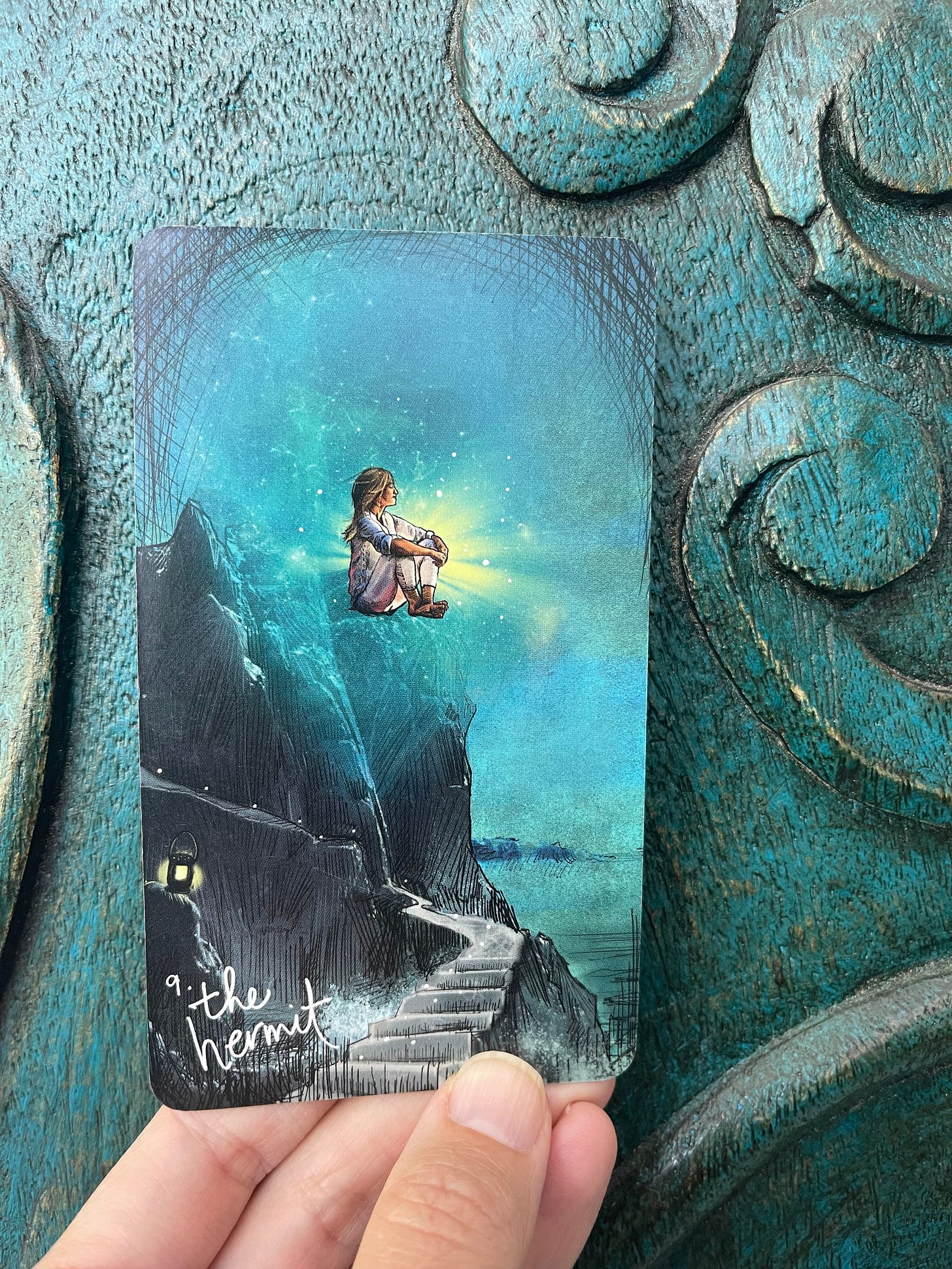The Hermit
among the misty mountains your inner wise one waits
THOUGH leaves are many, the root is one;
Through all the lying days of my youth
I swayed my leaves and flowers in the sun;
Now I may wither into the truth.
—William Butler Yeats
These days our Austin house is haunted by phantoms of Middle Earth, as my partner, Chris, and I, (re)read the Hobbit with our kids aloud before bed. Afterward, if we are feeling especially inspired by the barrel-riding and spider-slaying, we try to muddle through the new season of Rings of Power once the kids are in bed. In truth, without Tolkien’s careful control of his realm, we find the glut of characters and plot-lines a bit tedious, but we stay with it out of loyalty to our youth and the magic we once created around the world of Bilbo and his company. We brought so much of our own young lives into his unexpected journey from the safety of the Shire to the depths of the Lonely Mountain. A fool’s journey, archetypally reflective of our own, and not unlike what we see in the tarot’s progression through the major arcana. (Are you wondering if there’s a LOTR tarot deck out there? Do dwarves have beards?) If you like, imagine yourself inside of it while I play dungeon master for a spell:
With lip-cracking thirst and sway-legged confusion, you wander in darkness. Cold seeps through your ragged cloak and clutches at your skin. Behind you, the road crumbles to dust, leaving nothing but wilderness and void. The only conceivable direction to take is upward—and you ascend the rocky incline, though it disappears in black fog at the mountain’s peak. How long has it been since you set out with a cheerful song in your teeth and a yappy dog at your side? A lifetime ago? A year? A moment?
Once you traveled the world with your arms spread wide, taking in the vast, glorious sunrise. How could you have imagined then that your road would lead to such utter obscurity, complete unknowing, and near-despair? Yet here you are, just the same: cold, hopeless, lost. Unable to see your own hand in front of your face, you might as well be invisible. Only wait—there ahead—near a crevice in the rock, a light glimmers green and gold, like the gleam of a single firefly in the woods. You climb forward, shaking through the last few steps as the light grows larger. Its peridot glow beams inside a delicate metal frame—a lantern.
In your chest, a stir of hope—is this a fleck of the sunlight you once knew, a fellow-seeker come to guide you through the dark? Drawing closer to the glass you feel the light warm your cheek. You are found. Water stings your eyes as you choke through a sigh of relief. But who is this savior? Friend or Foe? In the clear pane of the lantern’s glass, a visage takes shape. You move closer. Peering into the light, you see a wizened, unkempt face.
Gandalf, you might think, and check the air around your head for smoke rings.
But no. The gnarled fingers holding the lantern aloft—are powered by your own solid grip. The face upon the surface of the glass—is your own aged face. The glimmering light inside—is your own inner knowing. You have come to the heart of the wilderness to meet your wisest self: the one who has left the lies of youth behind to wither into truth.
You have pulled the Hermit card—or—if you’re living through the astrological season of Virgo (August 23-September 22) you are experiencing the energy of a collective Hermit moment. Often the Hermit is said to announce the appearance of a wise teacher, Gandalf-like from the mist, or—more often—to signal an edict to retreat into a space of solitary reflection. Perhaps. Yet I can’t help but suspect that these external shifts only mark the interior change that the archetype more directly invokes.
My sense is that this stoic elder of the tarot arrives to bolster the confidence that we learn only through personal experience, embodied practice, and—often—age. Where the Fool celebrates our youthful exuberance, the Hermit champions the fruits of a long road of trial and error. We are not necessarily “alone,” but what was superfluous has fallen away — our bindle of belongings, and even our cute little pup, are absent. What is left? As activist and quaker writer, Parker Palmer has said of his own aging: “Coming to terms with the soul-truth of who I am — of my complex and often confusing mix of darkness and light — has required my ego to shrivel up. Nothing shrivels a person better than age: that’s what all those wrinkles are about!”
Chances are, if you’re pulling the Hermit, your ego has taken a hit or two. You’ve been knocked around a bit by the Eight Worldly Winds that Buddhist teacher, Ethan Nichtern, describes in his recent examination on what it means to face the weather-battered tightrope of hope and fear. When students are willing to examine what motivates their meditation practice, he writes, “we end up talking about trusting the choices we make, trusting the thoughts we think, and most deeply, trusting that we will be capable of navigating the unknown” (emphasis Nichtern’s). When the Hermit arrives for you, it’s time to draw focus to the spark of divinity that has survived with you this far—to identify what convictions will sustain you on this journey, what light in you is bright enough to guide your path through the dark and stormy passes ahead. In other words: heed the guidance of the wizard within.
Virgo season, with its back-to-school buckle-down and brass-tacks energy, supports our recommitment to the stirring of our inner sage, making the astrological season’s association with the Hermit card quite generative. After all, with the impending arrival of autumn we can’t help but remember that our time is limited. The year will soon draw to a close. Bare-branched trees will outline the destiny of our own aging bodies and model the prioritization of what is most essential to our continued well-being.
No matter your age, the wise one waits for you.
This is an opportune moment to practice Tara Brach’s meditation “Connecting to Your Loving and Wise Future Self.” Perhaps in the process you hone in on the red thread knotted in your wanderings since you began your journey in the Fool card. Perhaps you begin to marvel at what it is to hold a lantern in your hands at all. In the creative process, this can look like recommitting to our personal artistic vision, despite digressions we might have taken in response to advice of others. Yet the Hermit also asks us to have patience, reminding us that true clarity most often comes, not in a stroke of lightening, but through persistent curiosity paired with a willingness to trust your knowing even while uncertainty presses in from all sides. It helps to stop. Be still and totter for a moment with our cane, bring awareness to the winds that make our flame turn and dance within its lantern home.
Historically, the Hermit is a figure of monastic devotion, one willing to remove oneself from society and commit wholly to spiritual or religious practice—often taking up a simple life in communion with nature. They show up in Romantic paintings cloaked in rags subsumed in vast and emotive landscapes. The Hermit is the buddhist monk or Transcendentalist par excellence. From their Walden Pond retreat, they divest themself of the trappings of culture and recover their unique spiritual essence.
Maybe then, the arrival of the Hermit can best be honored by remembering our connection to other-than-human world. Under their influence, we may feel the impulse to practice the reverent observation of a sunset, the rising of the moon, the fading of a flower. Please, if you can, grab a pen right now and sketch a leaf—even if you have to reference a stock photo on your iPhone. How do you feel afterward? Subsumed in the natural world, the Hermit to helps us integrate this truth — though we are beset by failure after failure, ultimately we are as whole and blameless as nature itself.
This profound self-acceptance, does not release us from all accountability. Far from it. The light of the Hermit’s lantern has always served to illuminate what does not accord with our highest good and show the way toward transformation. That’s why in so many myths and legends the Hermit leaves his isolation to return to society as a truth-teller. The elder brother of the court jester (the Fool reasserted!), the Hermit steps out of his cave with the confidence to speak truth to power and, if necessary, upend the status quo. Like the reclusive Crone figures of the Grail Legend, the Hermit indicates where the hero went wrong and lost sight of the quest to restore what has been repressed or, in the case of Gawain’s Loathly Lady, to reinstate the sovereignty of the individual within the whole.
Among the rocky crags and dense woodlands of the psyche, the Hermit asks us to develop an Emersonian Self-Reliance — a willingness to follow our own path, regardless of how erratic our movements may look from the outside. But to follow the lantern-lit path requires deep wells of self-assurance. It demands a faith that asks more of us than did the Fool’s blind trust, because we know, by this time, what it means to fall down the ravine. Moreover, with the passage of time the way has likely narrowed. Will you risk the climb anyway?
Perhaps there’s no way to truly avoid it.
Maybe the better question then is—will you let yourself be fed and nourished by the light that only you can self-create?
I can’t help but notice how often we humans resist taking hold of practices that could truly nourish us (creative and spiritual practices) because they don’t “look” they way we think they “should.” Don’t fall into this trap! Like the Loathly Lady herself, our practices are waiting to transform us. What is potentially ‘repulsive’ to others becomes enchanting. Those willing to follow their inner Hermit will find solace, clarity and joy in his solitary refuge.
Do you remember the Goat Woman in Charles Frazier’s Cold Mountain? She rescues Inman from starvation after he escapes a chain gang and then wanders near-death into her mountain home. A reclusive forest witch with knowledge of herbs and a loving respect for the goats she raises to eat, she shares her truth, soothing draughts, and food to coax Inman back to health. Her wisdom provides the most life-giving of gifts. So, too, does the wise woman in you. You might have also noticed that Hermit even looks, in the Rider Waite Smith deck, a bit like Father Christmas. Fitting! On the darkest night of the year he appears with unexpected treats, life-affirming pleasures, and more than a little bit of magic to get us through the winter.
For further reflection:
As this Virgo/Hermit season draws to a close, ask yourself where you might be withering into the truth? Which branches are ready for pruning? Where might you welcome growth?
How can you strengthen your faith in the process of your soul’s evolution?
What treats and treasures support you on your path?
The (symbolic) hermitage provides an optimal setting for (literal) star-gazing. Go out into the night and feel what it is like to be in darkness, looking toward the light. The stars guided our ancestors for millennia. What celestial fires guide you?
May the lantern be bright upon your path and guide your journey — there and back again.





